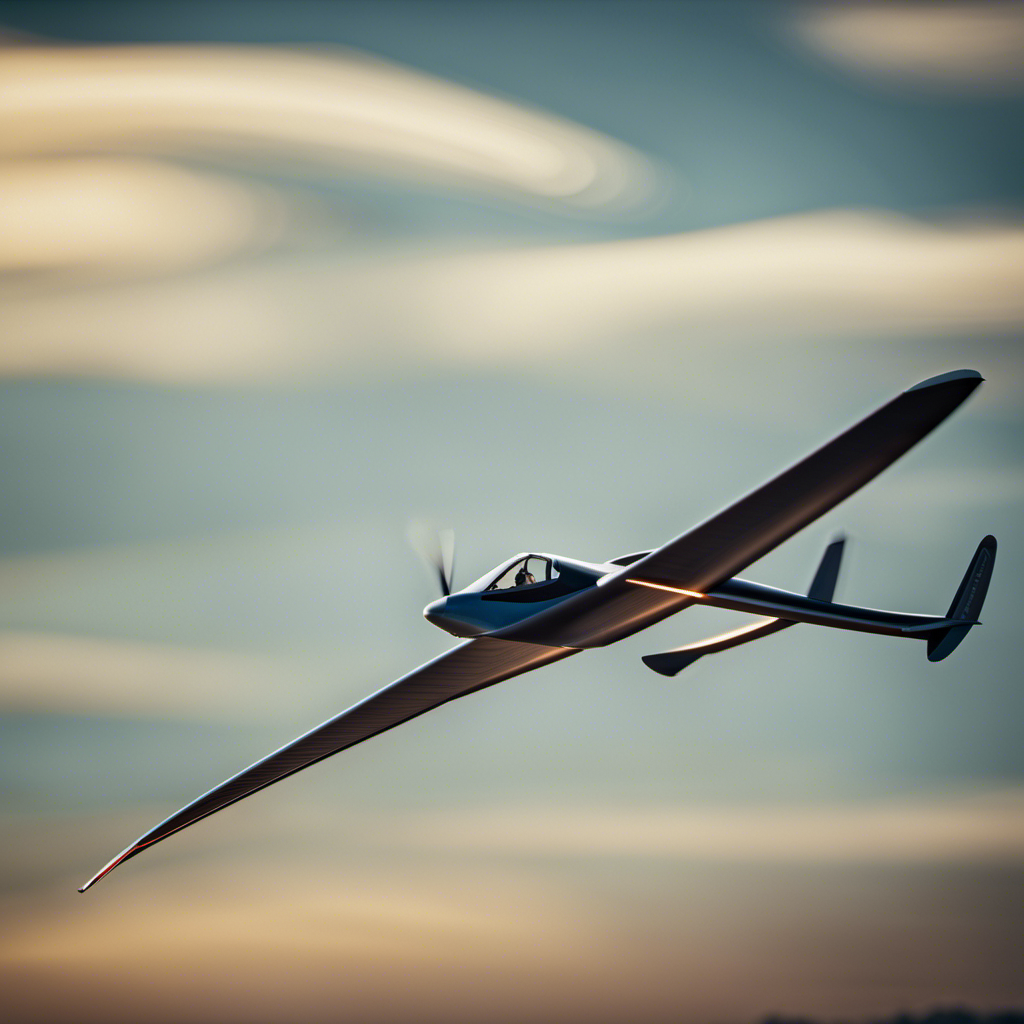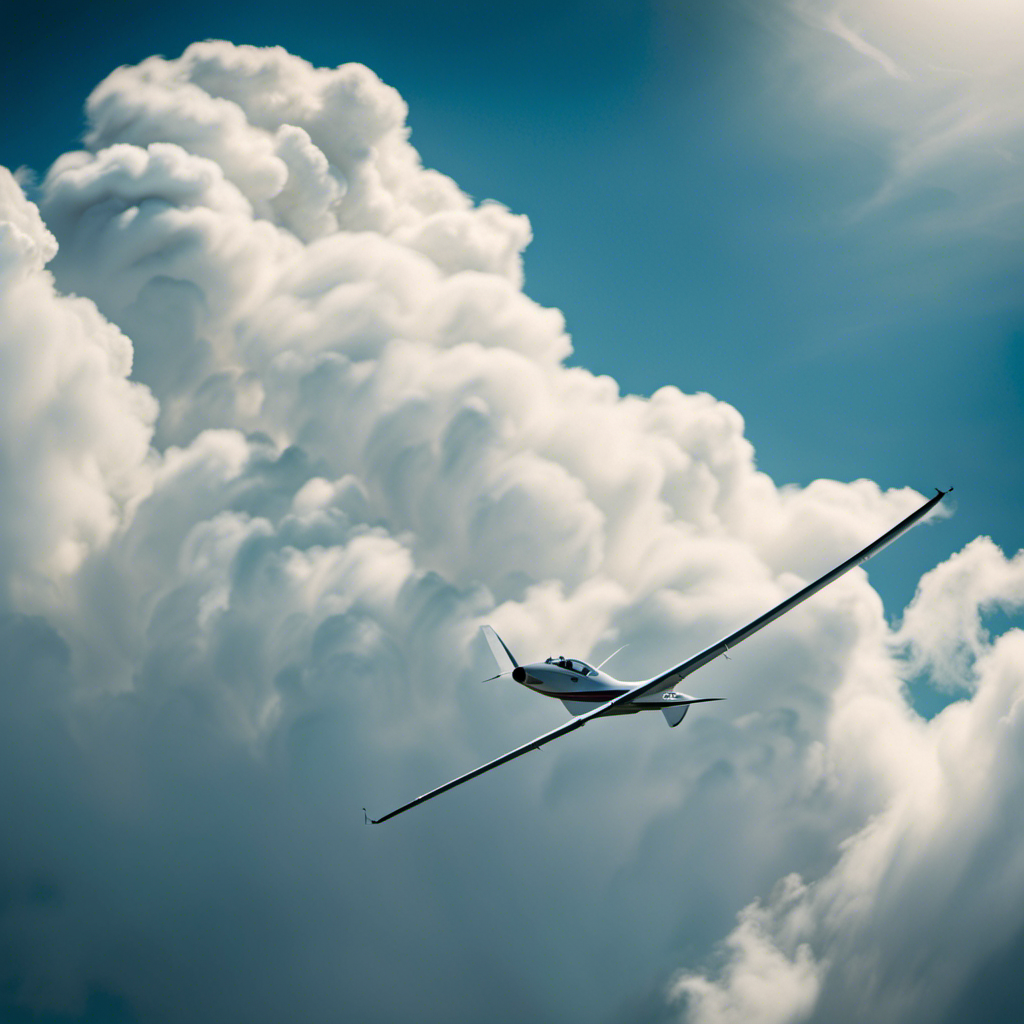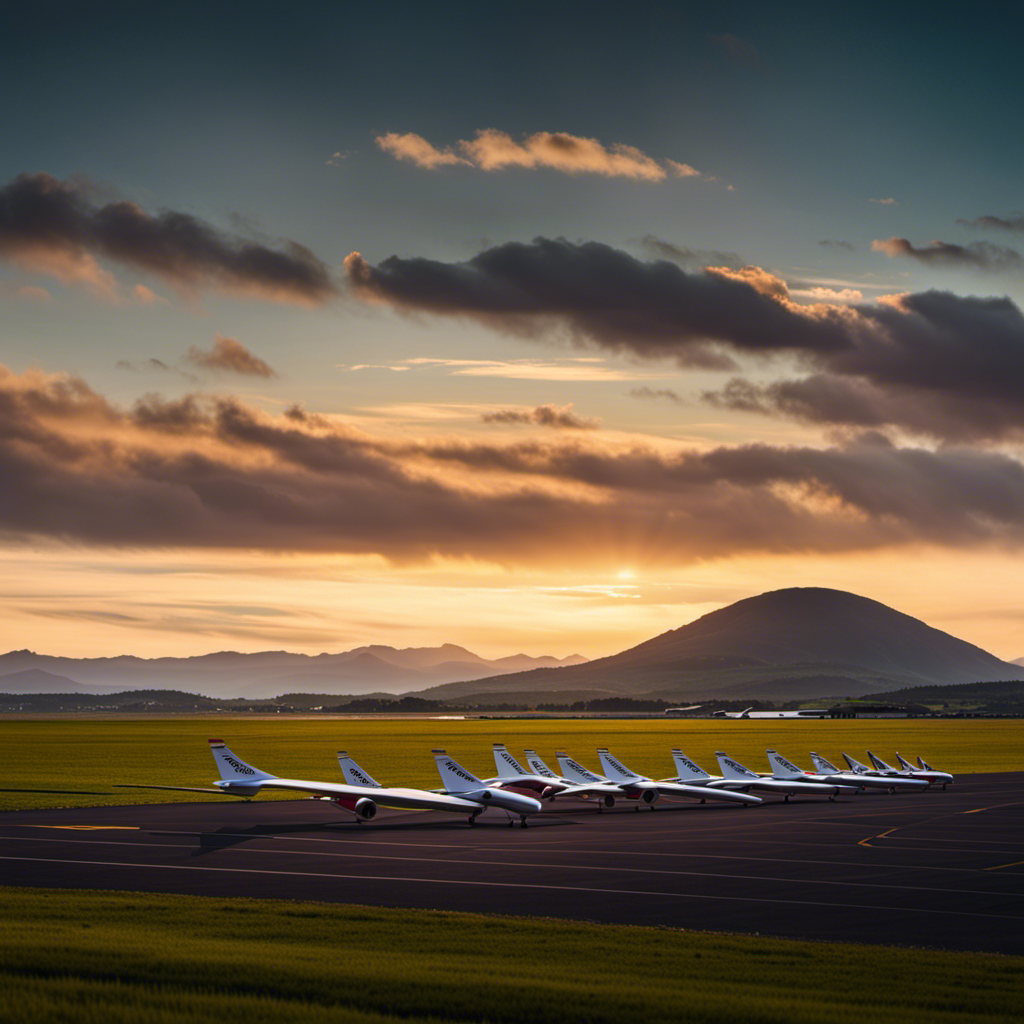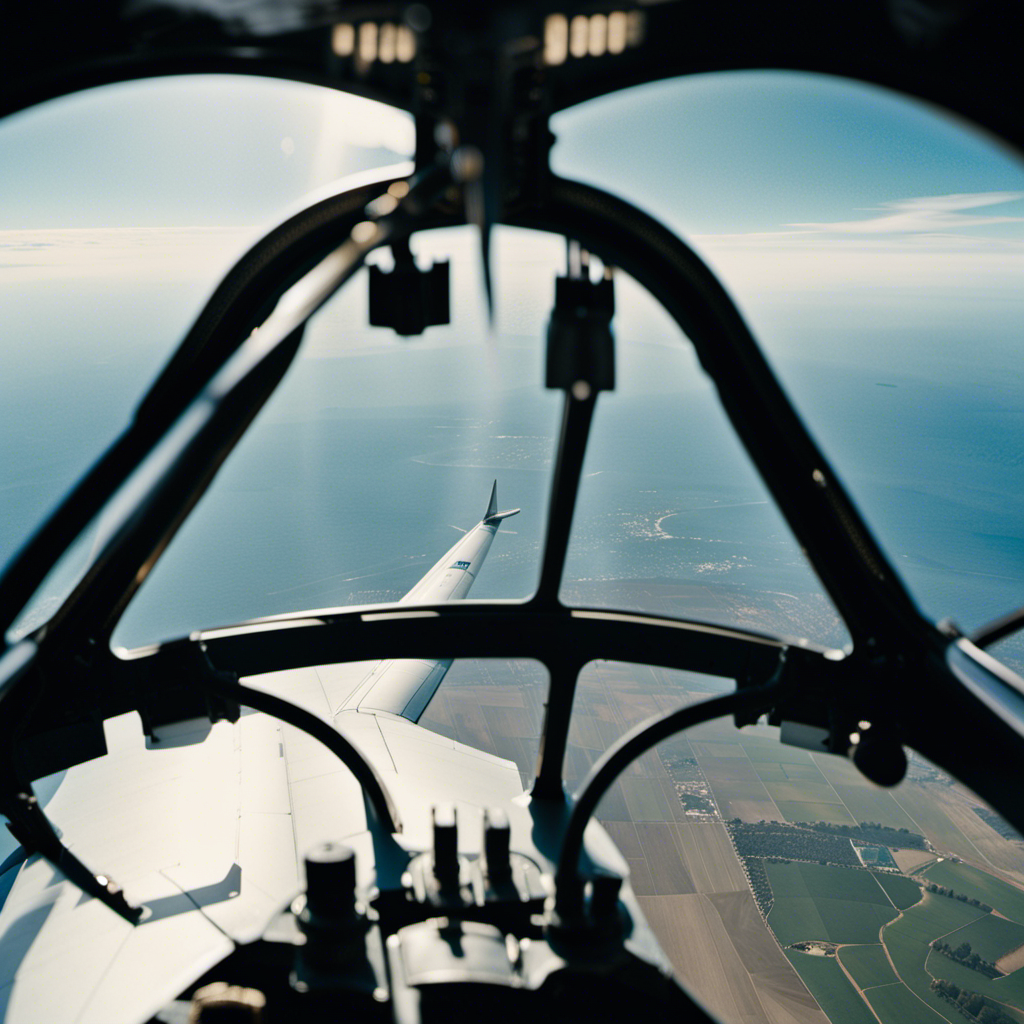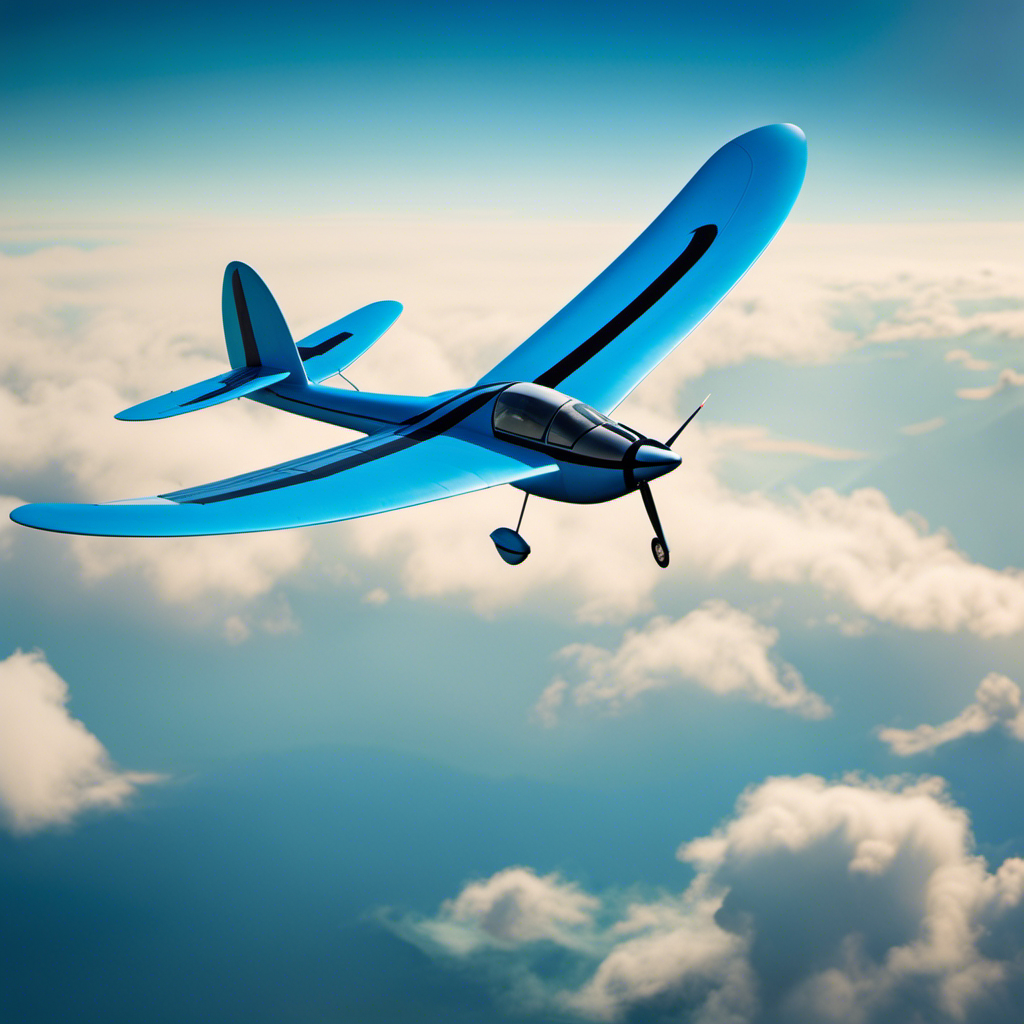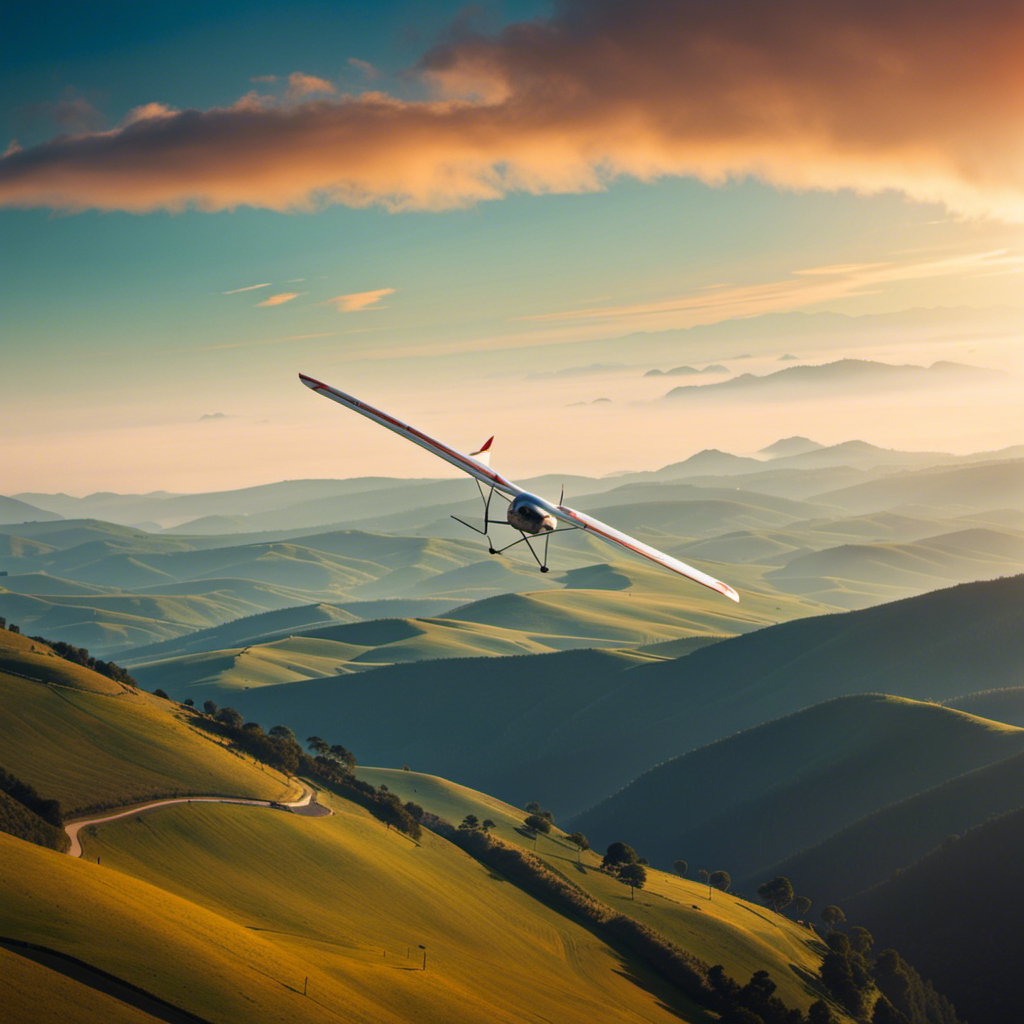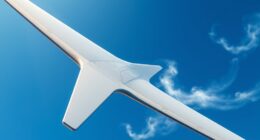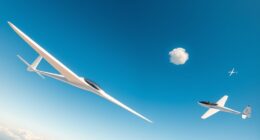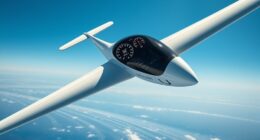As a lover of aviation, I have always been fascinated by the graceful and smooth movement of gliders as they soar through the sky without the need for engines. These aircraft effortlessly conquer gravity by silently gliding through the air.
But how do gliders take flight? In this article, we will delve into the intricacies of glider flight, exploring the basics, design, launching techniques, and the art of soaring.
Join me on this journey as we unravel the secrets behind the magic of gliding.
Key Takeaways
- Gliders use elevator mechanisms to control the pitch of the nose, with upward deflection causing the nose to pitch up and downward deflection causing the nose to pitch down.
- The rudder, located on the vertical stabilizer of the glider’s tail, plays a crucial role in maintaining directional control and controls the yaw or left/right movement of the glider.
- Gliders utilize thermals and ridge lift to gain altitude during flight, with thermals being circular air currents and ridge lift occurring when wind blows against a slope or ridge.
- Proper maintenance and regular inspections are essential for glider safety, including examining the airframe, control surfaces, landing gear, and addressing potential issues before they become hazards.
Understanding the Basics of Glider Flight
To understand the basics of glider flight, it’s important to know how gliders generate lift. Glider aerodynamics and the principles of glider flight play a crucial role in enabling these aircraft to stay airborne without an engine.
Gliders generate lift through a combination of factors, including their wing design and the flow of air over the wings. The shape of the wings, called an airfoil, is specifically designed to create lift.
As the glider moves forward, the air flowing over the wings creates a pressure difference, with lower pressure above the wings and higher pressure below. This pressure difference creates lift, allowing the glider to stay aloft.
Understanding the aerodynamics and principles of glider flight is essential to grasp the design and structure of gliders, which will be discussed in the subsequent section.
The Design and Structure of Gliders
You’ll notice that gliders have a sleek and aerodynamic design, allowing them to effortlessly soar through the air. This is achieved through careful consideration of glider materials and wing design.
Gliders are typically constructed using lightweight yet strong materials such as carbon fiber, fiberglass, and aluminum. These materials provide the necessary strength while keeping the overall weight of the glider low.
The wing design of gliders is crucial for their flight performance. Glider wings are designed to generate lift by creating a pressure difference between the upper and lower surfaces of the wing. This is achieved through the use of airfoil shapes, which are curved on the top and flat on the bottom.
The combination of glider materials and wing design enables gliders to achieve maximum efficiency and glide through the air with minimal resistance.
As we delve into the next section on launching techniques for gliders…
Launching Techniques for Gliders
When it comes to launching gliders, there are several techniques that can be employed.
The tow launch method involves a powered aircraft pulling the glider into the air using a long cable.
The winch launch method, on the other hand, utilizes a powerful winch to rapidly reel in a cable attached to the glider, propelling it into the sky.
Lastly, the aerotow launch method involves the glider being towed into the air by a larger aircraft, such as a tow plane.
Each method has its own advantages and considerations, and understanding them is crucial for a successful glider launch.
Tow Launch Method
The tow launch method is commonly used to help gliders take flight. This technique utilizes towing equipment, such as a powerful aircraft or vehicle, to pull the glider into the air. The glider is connected to the towing equipment using a release mechanism, which allows for a controlled separation once the desired altitude is reached.
Using the tow launch method can evoke a sense of anticipation and excitement, as the glider is slowly lifted off the ground, soaring higher and higher into the sky. It creates a thrilling experience for both the pilot and the passengers, as they rely on the towing equipment to provide the initial lift and momentum.
Transitioning into the subsequent section about the winch launch method, another method commonly used to launch gliders, we can explore a different approach to getting these graceful aircraft off the ground.
Winch Launch Method
To launch a glider using the winch method, simply attach the glider to the winch cable and prepare for an exhilarating takeoff.
The winch launch is a popular method among glider pilots due to its simplicity and efficiency.
As the winch rapidly pulls in the cable, the glider gains speed, allowing it to generate lift and take to the skies.
Glider aerodynamics play a crucial role in this process, as the dynamic soaring technique is utilized to maximize lift and maintain altitude.
By exploiting the energy of the wind, gliders in dynamic soaring can achieve remarkable speeds and endurance.
Transitioning to the aerotow launch method, another common technique, involves connecting the glider to a powered aircraft for a smooth and controlled ascent.
Aerotow Launch Method
Connect yourself to the powered aircraft using the aerotow launch method and get ready for a smooth and controlled ascent.
In this method, a tug aircraft tows the glider into the air using a tow rope. The tug aircraft, equipped with a powerful engine, provides the necessary propulsion for both aircraft during the initial climb.
Once the desired altitude is reached, the glider release mechanism is activated, disconnecting the tow rope from the tug aircraft. This allows the glider to separate and continue its flight independently.
The aerotow launch method offers several advantages, including the ability to reach higher altitudes and longer flight durations compared to other launch methods.
Now that we have successfully released from the tug aircraft, let’s explore how to control a glider in flight.
Controlling a Glider in Flight
When it comes to controlling a glider in flight, there are three key components that play a crucial role: ailerons, elevators, and the rudder.
Ailerons are responsible for controlling the roll of the glider, allowing it to bank left or right.
Elevators, on the other hand, control the pitch of the glider, enabling it to climb or descend.
Lastly, the rudder helps to control the yaw of the glider, allowing it to turn left or right.
Understanding the function and importance of these control surfaces is essential for safe and effective glider control.
The Role of Ailerons in Glider Control
Ailerons are crucial for controlling the movement and stability of gliders. These control surfaces, located on the outer trailing edge of each wing, enable the pilot to manipulate the roll of the aircraft. By raising one aileron and lowering the other, the glider can be banked into a turn. This asymmetric lift distribution causes the glider to roll about its longitudinal axis, allowing for precise control of its direction.
The mechanics behind aileron movement involve a combination of mechanical linkages and hydraulic or electric actuators. This allows for smooth and responsive control inputs, enhancing glider maneuverability. Ailerons play a vital role in ensuring the glider can perform various flight maneuvers, including coordinated turns and banking.
Transitioning to the function of elevators in glider control, elevators are responsible for controlling the pitch of the aircraft.
The Function of Elevators in Glider Control
As we explored the role of ailerons in glider control, we now turn our attention to another crucial component of flight: the elevators. The elevators, located on the horizontal stabilizer of the glider’s tail, play a vital role in maintaining glider stability and controlling pitch.
To understand the function of elevators, envision the following scenarios:
- Imagine the elevator mechanism as a pair of wings attached to the tail, capable of moving up and down.
- When the elevators are deflected upward, they create a downward force on the tail, causing the glider’s nose to pitch up.
- Conversely, when the elevators are deflected downward, they generate an upward force on the tail, resulting in the glider’s nose pitching down.
By skillfully manipulating the elevators, pilots can control the glider’s pitch and maintain stability during flight.
Now, let’s delve into the importance of the rudder in glider control…
The Importance of Rudder in Glider Control
The rudder, located on the vertical stabilizer of the glider’s tail, is essential for maintaining directional control during flight. It plays a crucial role in ensuring the glider stays on course and responds to input from the pilot. The rudder works by deflecting airflow, creating a force that helps the glider turn left or right. Without the rudder, the glider would struggle to maintain a steady heading and would be at risk of veering off course.
To further emphasize the importance of the rudder in glider control, consider the following table which highlights the primary control surfaces on a glider:
| Control Surface | Location | Function |
|---|---|---|
| Rudder | Vertical Stabilizer | Controls the yaw or left/right movement of the glider |
| Elevator | Horizontal Stabilizer | Controls the pitch or up/down movement of the glider |
| Ailerons | Wings | Control the roll or banking movement of the glider |
As you can see, the rudder is responsible for controlling the yaw, which is crucial for maintaining directional control. Now that we understand the significance of the rudder, let’s explore the soaring techniques for gliders.
Soaring Techniques for Gliders
One popular technique for gliders to gain altitude is by using thermals. Thermals are rising columns of warm air that can be found in certain atmospheric conditions. Glider pilots rely on their knowledge of thermals to navigate and stay aloft.
When a glider enters a thermal, it uses the upward movement of the air to climb higher. By circling within the thermal, the glider can maintain and even increase its altitude.
Another technique for gaining altitude is ridge lift. This occurs when wind blows against a slope or ridge, causing the air to rise. Gliders can take advantage of this upward movement to gain altitude without the need for an external heat source.
Understanding these soaring techniques is crucial for glider pilots to stay airborne and explore the sky with grace and skill.
Now, let’s delve into the art of landing a glider safely.
Landing a Glider Safely
To safely land a glider, pilots must carefully control their descent and smoothly bring the aircraft to the ground. Landing techniques are crucial for a successful touchdown. The pilot needs to assess the wind direction and speed, as well as the runway conditions, to determine the best approach.
Maintaining a proper glide path is essential, using a combination of airspeed and altitude control. As the glider nears the ground, the pilot must flare, or raise the nose, to reduce the descent rate and allow for a gentle touchdown.
In emergency landings, pilots may have to choose alternative landing sites or perform a forced landing. These situations require quick decision-making and precise execution. Mastering landing techniques is vital to ensure the safety of both the pilot and the glider.
Moving on to glider maintenance and safety, it is important to regularly inspect the aircraft for any damage or wear.
Glider Maintenance and Safety
Regularly inspecting gliders for damage or wear is essential for maintaining their safety and airworthiness. Glider maintenance involves a thorough examination of all components, including the airframe, control surfaces, and landing gear. This ensures that any potential issues are identified and addressed before they become a safety hazard. Additionally, routine maintenance tasks such as lubricating moving parts and checking fluid levels help to keep the glider in optimal condition. To illustrate the importance of glider maintenance, consider the following table:
| Component | Inspection Frequency | Maintenance Tasks |
|---|---|---|
| Airframe | Before and after flights | Check for cracks or corrosion |
| Control Surfaces | Before and after flights | Ensure proper alignment |
| Landing Gear | Before every flight | Check for wear or damage |
Advancements in Glider Technology
Advancements in glider technology have led to improved aerodynamics and increased efficiency. Electric gliders, powered by electric motors, have become increasingly popular due to their environmental friendliness and quiet operation.
These gliders can be recharged using renewable energy sources, making them more sustainable compared to traditional gliders that rely on fossil fuels. Autonomous gliders, equipped with advanced navigation systems and sensors, are also emerging in the field. These gliders are capable of flying without human intervention, using artificial intelligence algorithms to make decisions based on real-time data.
This technology not only enhances safety but also allows for longer and more precise flights. With these advancements, glider competitions and events have become even more exciting, as pilots can showcase their skills in high-performance electric and autonomous gliders.
Glider Competitions and Events
Glider competitions and events are a thrilling showcase of pilots’ skills, where they can demonstrate their abilities in high-performance electric and autonomous gliders. These events not only provide an opportunity for pilots to compete against one another, but they also serve as a platform for advancing glider safety and training.
Here are four key aspects that highlight the importance of glider safety and training in these competitions:
-
Pre-flight inspections: Pilots meticulously check their gliders before each flight to ensure that all components are in proper working order.
-
Emergency procedures: Competitors are trained to handle various emergency scenarios, such as mid-air collisions or equipment failures, to ensure their safety and the safety of others.
-
Weather awareness: Understanding weather patterns and their effects on glider performance is crucial for making informed decisions during competitions.
-
Skill development: Glider training programs help pilots improve their flying techniques, enabling them to navigate through challenging flight paths with precision and confidence.
Joining the Gliding Community
When joining the gliding community, aspiring pilots can expect a supportive and inclusive environment that encourages skill development and promotes safety. It is important to find a gliding club that aligns with your goals and values.
Joining a club provides access to experienced pilots who can serve as mentors and provide guidance throughout your journey. These mentors can offer valuable insights, share their knowledge, and help you navigate the intricacies of gliding.
Additionally, being part of a club allows you to connect with like-minded individuals who share your passion for gliding. This sense of community fosters camaraderie and provides opportunities for collaboration and learning.
Finding a mentor within the gliding community can greatly enhance your learning experience and accelerate your progress as a pilot.
Frequently Asked Questions
How long can a glider stay in the air without an engine?
A glider can stay in the air without an engine for several hours, thanks to its efficient design and the principles of glider aerodynamics. This allows for increased glider endurance and prolonged flight times.
Are there any age restrictions for flying a glider?
There are age restrictions for flying a glider, but with the right training requirements, anyone can learn. It’s important to undergo proper instruction to ensure safety and proficiency in glider flying.
Can gliders fly in bad weather conditions?
Glider safety precautions include closely monitoring weather conditions. Bad weather, such as high winds or storms, can significantly impact glider flight performance. It’s essential to avoid flying in unfavorable weather conditions to ensure safety.
Do gliders have any means of communication with ground control?
From the ground, I relay crucial information to ground control using advanced communication methods. They guide me through the skies, ensuring our flight remains safe and successful.
What is the maximum altitude a glider can reach?
The maximum altitude a glider can reach depends on various factors such as glider performance and atmospheric conditions. However, it is not directly related to the question of how gliders take flight.
Conclusion
As I prepare to land my glider, I am reminded of the beauty and grace of flight. The glider, with its sleek design and strong structure, effortlessly glides through the air. It is a symbol of freedom and adventure, allowing me to soar above the world below.
Through precise control and mastery of soaring techniques, I navigate the skies with ease. As advancements in glider technology continue to push the limits, the gliding community grows, and the thrill of competing in glider events awaits.
Join me in the skies, where the possibilities are endless.
